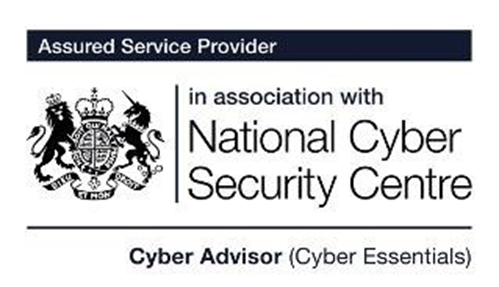Ninety-five per cent of cyber attacks start with an employee being tricked.
If you want to prevent cyber breaches, it’s time to be proactive in your approach to cyber security. In this 10-point guide to creating a cyber security plan for your business, we’ll identify the primary factors that contribute to cyber security mistakes and what you can do to mitigate them.
Why trust this blog with your cyber security plan?
Our cyber security expert technicians and consultants are industry-leading providers of services and solutions that safeguard many businesses across the UK from cyber threats. From providing training to introducing cyber security measures, we know everything there is to know about cyber security.
In this cyber security plan, we pass what we can over to you.
Cyber Security Plan Point 1: Train Your Staff
When it comes to cyber security, ignorance certainly is not bliss.
If your staff are unaware of the threats they face, they cannot and will not change their risk-prone behaviours, which means they are much more likely to fall prey to a cyber attack than those who know about potential cyber threats.
Training is the first-line defence against cyber attacks. Educate your team about the dangers they may come up against in their day-to-day activities, from using unsecure networks and devices to phishing emails and potential data theft.
Cyber Security Plan Point 2: Assign Responsibility
There should always be somebody within your organisation who has overall responsibility for deploying cyber security and the management of its processes and policies.
The purpose of an assigned individual is to ensure total clarity across your entire workforce as to how cyber security is managed and who to go to for cyber security issues.
Without an assigned individual responsible for the cyber security process, you face confusion and potential mismanagement of security issues as people are unsure of who should be doing what.
Cyber Security Plan Point 3: Control Your Data Access
The more people with access to data, the greater the risk of somebody accidentally giving cyber criminals access. By controlling the number of individuals that can access certain information, you can reduce risk.
Avoid business-wide admin accounts and instead establish user-specific logins with permissions, access and restrictions.
Not only does this help prevent data breaches, but it also helps you identify where the breach came from if one should occur — this is not about blame but instead about knowing how to resolve security flaws.
Cyber Security Plan Point 4: Understand the Risks
Educating your staff on risks is a vital thing to do.
However, you can only educate them on the risks you know about — unless you outsource your training, which we highly recommend. This is a cyber security service we can offer.
To stop new cyber threats from becoming serious problems for your business, it’s important to maintain an awareness of the current and common issues hitting other commercial enterprises.
By keeping yourself aware of the risks, you can understand your position and what other steps you may need to take to prevent them from affecting you. This could range from investing in more comprehensive cyber security software to updating and patching your systems to include new security protocols.
Cyber Security Plan Point 5: Secure Your Passwords
It might seem obvious, but good cyber security plans should always include password development policies.
If your passwords are weak, then hackers can crack them. If they go unchanged, then any breaches of third-party systems that reveal them to black-market buyers may leave you vulnerable.
Encourage activities such as routine password updates, introducing further authentication where possible, and always having a complex and difficult-to-guess password.
Cyber Security Plan Point 6: Encrypt Your Data
Data encryption should never be underestimated as a tool for protecting your valuable digital assets.
Encryption is highly effective at keeping hackers away from your data.
It works like this:
You invest in software that scrambles your data. The only way to unscramble the data is with the encryption key that decodes the data. If you separate access controls like passwords from the encryption key, it means that even if a hacker were to trick a member of staff into giving away sensitive business login details, the hacker does not have the encryption key, and therefore, cannot access files on your system.
Cyber Security Plan Point 7: Implement Cyber Security Compliance
Cyber Security Essentials (and Cyber Security Essentials Plus) are important certifications for your business, as are ISO accreditations. These accreditations not only demonstrate to others that you are managing cyber security risk, but they also help ensure you’re taking the right steps to secure your business.
By working to achieve these accreditations, you’ll be able to find areas of improvement and use this to forge a stronger and more resilient cyber security strategy.
Cyber Security Plan Point 8: Manage Your Supply Chain Risks
You are only as strong as your weakest link.
If your suppliers are vulnerable to cyber attack, that means they could lose your data as well. Their hacked systems could also be used to trick your employees into giving up information or system access.
Audit your suppliers for cyber security compliance certification, and avoid working with any vendors not taking their cyber security seriously.
Cyber Security Plan Point 9: Test Your Systems
Cyber penetration testing is a form of cyber security analysis that allows you to find out if your systems are vulnerable to attack.
The process is simple.
A team of cyber security experts will purposefully attempt to hack your network. They will not unleash malicious software or steal data as a hacker might, but instead, they will follow the same steps as a cyber criminal to see if they can penetrate your cyber security defences.
Through cyber security testing, businesses can identify their weaknesses and make changes to strengthen them. This could be anything, from finding out employees who will give away access controls if tricked to vulnerabilities in business applications.
Cyber Security Plan Point 10: Support Your Cyber Security Efforts
Cyber security plans need advanced support networks to ensure they are effective.
Without up-to-date knowledge and insight into cyber security threats, your business is at risk of using outdated strategies, cyber security tools and safeguarding procedures.
The best way to support your cyber security plan is through IT consultancy services. These third-party services can keep you aware of trending threats and ensure you maintain modern standards of compliance and risk assessment.
Protect Your Business and Optimise Your Cyber Security Plan with Optimising IT
We are your cyber security experts. Our award-winning technical engineers and IT consultants can support your data protection goals and ensure you are prepared for the cyber threats that pose a risk to your business. Contact our team today to discuss how we can help build your cyber security plan.












